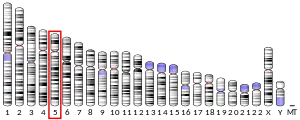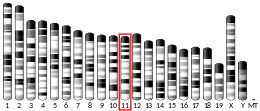NIPAL4
Nipa‐Like Domain‐Containing 4, also known as NIPAL4 or Ichthyin, is a gene that is predicted to code for a transmembrane protein with nine transmembrane domains.[5] NIPAL4 codes for the protein magnesium transporter NIPA4, which acts as a Mg2+
transporter.
| NIPAL4 | |||||||||||||||||||||||||||||||||||||||||||||||||||
|---|---|---|---|---|---|---|---|---|---|---|---|---|---|---|---|---|---|---|---|---|---|---|---|---|---|---|---|---|---|---|---|---|---|---|---|---|---|---|---|---|---|---|---|---|---|---|---|---|---|---|---|
| Identifiers | |||||||||||||||||||||||||||||||||||||||||||||||||||
| Aliases | NIPAL4, ARCI6, ICHTHYIN, ICHYN, NIPA like domain containing 4, SLC57A6 | ||||||||||||||||||||||||||||||||||||||||||||||||||
| External IDs | OMIM: 609383 MGI: 2444671 HomoloGene: 133769 GeneCards: NIPAL4 | ||||||||||||||||||||||||||||||||||||||||||||||||||
| |||||||||||||||||||||||||||||||||||||||||||||||||||
| |||||||||||||||||||||||||||||||||||||||||||||||||||
| |||||||||||||||||||||||||||||||||||||||||||||||||||
| |||||||||||||||||||||||||||||||||||||||||||||||||||
| |||||||||||||||||||||||||||||||||||||||||||||||||||
| Wikidata | |||||||||||||||||||||||||||||||||||||||||||||||||||
| |||||||||||||||||||||||||||||||||||||||||||||||||||
Expression
NIPAL4 is mainly expressed in the skin, specifically in the granular layer of the epidermis.[6]
Function
NIPAL4 codes for a magnesium transporter that can also transport other divalent cations such as Ba2+, Mn2+, Sr2+ and Co2+, though to a much less extent than Mg2+.[5] There is also evidence that NIPAL4 is involved in the synthesis of very long chain fatty acids involved in the epidermal lipid metabolism.[7] Disruptions to this pathway results in impaired skin function, causing the symptoms of ARCI.[8]
Pathology
Mutations in this gene account for 16% of autosomal recessive congenital ichthyosis (ARCI) cases, making it the 2nd most common gene involved with this disease.[9] Since its first identification in 2004, 18 disease‐causing mutations have been reported in NIPAL4.[8]
References
- GRCh38: Ensembl release 89: ENSG00000172548 - Ensembl, May 2017
- GRCm38: Ensembl release 89: ENSMUSG00000020411 - Ensembl, May 2017
- "Human PubMed Reference:". National Center for Biotechnology Information, U.S. National Library of Medicine.
- "Mouse PubMed Reference:". National Center for Biotechnology Information, U.S. National Library of Medicine.
- Lefèvre C, Bouadjar B, Karaduman A, Jobard F, Saker S, Ozguc M, et al. (October 2004). "Mutations in ichthyin a new gene on chromosome 5q33 in a new form of autosomal recessive congenital ichthyosis". Human Molecular Genetics. 13 (20): 2473–82. doi:10.1093/hmg/ddh263. PMID 15317751.
- Wajid M, Kurban M, Shimomura Y, Christiano AM (2010). "NIPAL4/ichthyin is expressed in the granular layer of human epidermis and mutated in two Pakistani families with autosomal recessive ichthyosis". Dermatology. 220 (1): 8–14. doi:10.1159/000265757. PMC 2855276. PMID 20016120.
- Mauldin EA, Crumrine D, Casal ML, Jeong S, Opálka L, Vavrova K, et al. (June 2018). "Cellular and Metabolic Basis for the Ichthyotic Phenotype in NIPAL4 (Ichthyin)-Deficient Canines". The American Journal of Pathology. 188 (6): 1419–1429. doi:10.1016/j.ajpath.2018.02.008. PMC 5971224. PMID 29548991.
- Ballin N, Hotz A, Bourrat E, Küsel J, Oji V, Bouadjar B, et al. (December 2019). "Genetical, clinical, and functional analysis of a large international cohort of patients with autosomal recessive congenital ichthyosis due to mutations in NIPAL4". Human Mutation. 40 (12): 2318–2333. doi:10.1002/humu.23883. PMID 31347739.
- Fischer J, Bourrat E (March 2020). "Genetics of Inherited Ichthyoses and Related Diseases". Acta Dermato-Venereologica. 100 (7): adv00096-196. doi:10.2340/00015555-3432. PMID 32147747.



